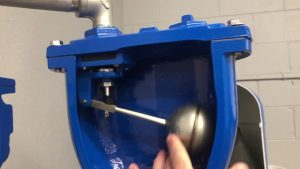A Detailed Introduction to Valve Bonnet & Gate Valve Internals and Body / Bonnet Designs
What is a Valve Bonnet?
Valve Bonnet is an assembly including the part through which a valve plug stem moves and a means for sealing against leakage along the stem. It usually provides a means for mounting the actuator. Sealing against leakage may be accomplished by packing or a bellows. A bonnet assembly may include a packing lubricator assembly with or without isolating valve. Radiation fins or an extension bonnet may be used to maintain a temperature differential between the valve body and sealing means.
The bonnet of valve is second principal pressure boundary of a valve. It is cast or forged of the same material as the body and is connected to the body by a threaded, bolted, or welded joint.
Types of Valve Bonnet
- STANDARD BONNET
- EXTENDED BONNET
- CRYOGENIC BONNET
- BELLOWS SEAL BONNET
Internals Parts of the Gate Valve
Valve professionals often refer to the term “internals” when it comes to industrial gate valves. However, their focus is not the quality but the internals’ withstandability of poor working conditions like the extreme stress with corrosion. The internals in the gate valve are the stem, the disc seal area, the seat and the upper seal (if any). For bronze and brass valves, their internals are usually built with the same material as that of the body and bonnet.
Cast iron and ductile iron valves have all iron internals, or occasionally, bronze ones. The iron valve with bronze internals is known as the “iron body, bronze mounted” or just IBBM. For its weldability, steel valves can be equipped with a wide variety of internals, such as Stellite, Hastelloy, 316ss, 347ss, Monel and No. 20 alloy.
Most 19th century valves were thread-ended ones, among which the bell threaded valve can be up to 12 inches long. Flange-ended valves became popular afterwards. Nowadays, other connections in use are thread ended, ring ended, Victaulic, Greyloc, and water specialized “mechanical ended” ones.
What is the bonnet of a gate valve?
Valve bonnets are other important components for the gate and globe type. By dismantling the bonnet, the maintenance staff has access to the internal mechanisms and can replace components like the seat, the stem, etc (trim).
Valve bonnets are available in many designs and models (the most typical are: bolted, round bolted, welded, pressure seal) and are manufactured in cast steel or forged steel (generally using the same material grade of the body). The bonnet is connected with the body by a threaded, bolted, or welded joint connections – and different types of gaskets are used to ensure leak-free connections between the body and the bonnet.
Manufacturers strive to optimize the design of this part (to reduce the overall dimension of the device and to ensure that the connection is tight and leakage-proof).
Structural Designs of the Body / Bonnet
Designs usually yield five different gate body / bonnet connections. They are threaded, union, bonnet bolted, bonnet welded and pressure sealed ones.
Threaded connection is the simplest design applied only for bronze valves, which are relatively cheaper and seldom to be taken down.
The union connection, which is used primarily for bronze valves likewise, is designed to facilitate the maintenance and disassembly.
The bonnet bolted connection is the most common one of the connections and is everywhere in major industrial gate valves. In order to seal the gate valve, gaskets are required inbetween the body and the bonnet in the case of threaded and union connections.
The pressure sealed connection achieves its sealing by means of the medium pressure acting on the wedge-shaped soft iron or the spherical ink gasket between the body and the bonnet. Therefore, the higher the pressure in the body cavity, the greater the force acting on the gasket. It is much lighter than the bonnet bolted one.
The bonnet welded connection is the most common construction for compact steel valves of 1 / 2 to 2 inches with pressure levels between 800 and 2,500 PSI, which is seldom to be taken apart. Similar to the case of the pressure sealed valve, the bonnet welded valve is lighter than the bonnet bolted one.
Above is a detailed introduction to gate valve internals and body /bonnet designs.












